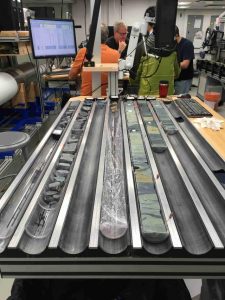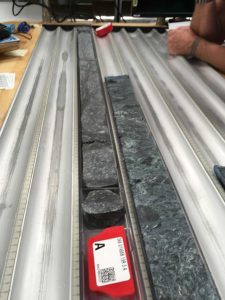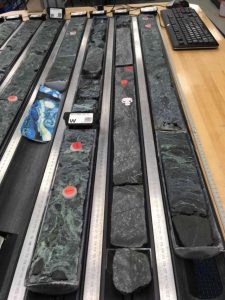
Magnificence (back) at Fantangisna, and Playing Catch-up…
Sorry to have been offline so long – but we have been BUSY here!
When I last blogged we were doing an elaborate set of re-visits of all of the summits of our three seamounts – Yinazao, Asut Tesoru, and Fantangisna – to check on the fidelity of the cased holes we had drilled. One of them – Asut Tesoru – actually needed to be cleaned out because serpentine muds were actively rising up the pipe (!!), so we cored and collected that mud and its associated waters (creating a sudden rush in our lab), while the drillers dropped concrete down into the hole to keep it from happening anymore. We then moved on back to Fantangisna, and after assuring ourselves that our summit hole was stable, we thrustered slowly (at ~1 knot) away to begin drilling at our last approved site on the Fantangisna seamount’s flank.


This flank hole was different from the start: first we hit rocks (!!!) – fresh chunks of ultramafic rock, like we hadn’t seen all Expedition (it got the Core Description team very excited!). And then it was colored sand – and then quickly blue, drilling-disturbed mud like we’d been seeing – and then the mud turned red (???). And then we were in brown volcanic clays and ashes, all in less than 40 m of drilling. Now this last bit was a good thing – one of the targets for the flank hole here was to drill through serpentinite and hit the “basement” sediments and volcanic rocks, and it looked like we did that, but it had happened too shallow to meet the other Site objective, which was to conduct a geophysical log of the hole to provide more insights into the seamount’s interior structure. Our conclusion was that we were TOO far downslope, so they revved up the thrusters and slowly moved us about 600+ meters uphill to try again.
Our magnificent last drillhole at Fantangisna – Hole U1498B:




Rocks. HUGE, thick rocks. More and swirlier muds. More core – recovery was incredible, up to 8 m of a 9.5 m core section, which given that we were doing Rotary Core Barrel (RCB) drilling was astonishing. More work – squeezing these hard muds (5-6 hours to get any porefluids out of them!), while trying to analyze the rocks from the other sites that we’d already collected and prepared. And it went on for 250+ meters of drilling, until we hit those ashes again which told us we were finally through the flank of Fantangisna and into the crust it sits on. The hole amazingly maintained its stability and we were able to log it from top to bottom, so we have a geophysical record of the interior of Fantangisna to compare to our rock record. A more successful hole there could not be. An excellent way to finish our explorations!


We are now on a long (7 day) transit from Fantangisna, past the Mariana islands and Taiwan and across the North China Sea to Hong Kong, where our cruise will officially end. Before that, however, is finalizing our reports on our findings, and (in the Geochemistry Lab) our usual game of catch-up, as we analyze all the samples we collected from Holes U1498A and B. Some of this we had to get done before transit (our ICP-AES instrument doesn’t like ship motion….) but the rest will continue for several days, after which we’ll scramble to get our final Site Chapters completed and revised. And we’re finalizing the samples we’ll take home to our labs to continue our work, to fully flesh out the geology (and biology) of this unique place on our planet.
[I promise to make 1-2 more entries in the next couple days, to make up for being preoccupied – so stay tuned!]